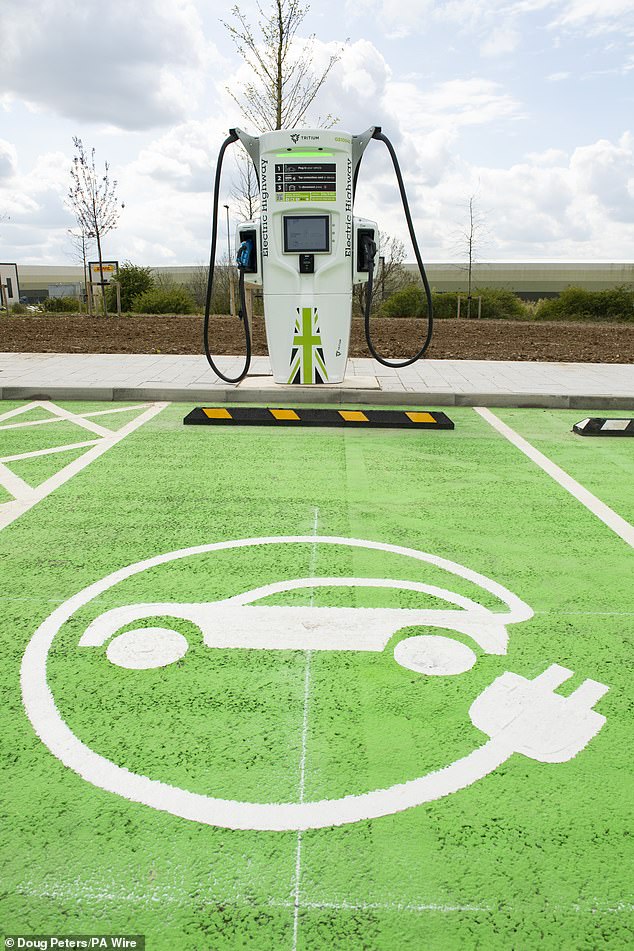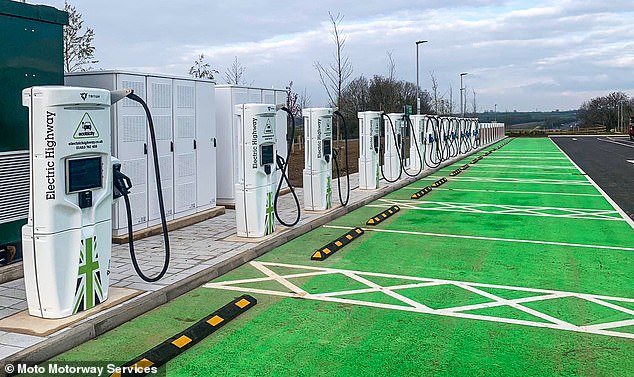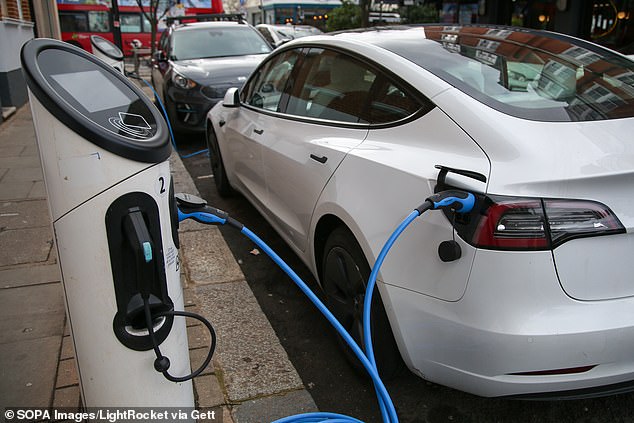
The Government is on course to miss a major target it set for bolstering the nation’s electric vehicle (EV) charging infrastructure.
Just over a year ago, the Department for Transport pledged to ‘ensure that every motorway service area has at least six rapid chargers by the end of 2023’.
However, the reality shows that just 27 out of 119 motorway services in England currently have six or more high-powered devices.

Government to miss motorway EV charging targets: The DfT pledged that every service station in England will have at least six ‘rapid’ chargers by the end of 2023
Ministers also set out an objective to have 300,000 public charging points in place across Britain by 2030.
But with just over 40,000 in place currently, the Government needs to increase its average monthly installations by what appears an insurmountable 215 per cent.
The RAC on Friday flagged the DfT’s likely failure to meet its target for motorway service station charging points.
It stated that fitting high-powered chargers is ‘not straightforward’ and urged ministers to ‘make this process simpler’.
Rapid charging points typically offer speeds above 43 kilowatts (kW) while ultra-rapid devices provide in excess of 100kW.
Rapid devices can add around 100 miles of range to an EV in just 35 minutes while ultra-rapid chargers can boost a battery from 10 to 80 per cent capacity in less than half an hour.
It is these types of device with the shortest charging times that are seen as crucial to encourage more motorists who use their cars for long journeys to make the switch from petrol or diesel to electric.
In a DfT document published in March 2022 it stated that ‘many operators’ of motorway services had ’embraced the ambition’ to install six high-powered chargers by the end of 2023, with ‘over 70 per cent’ of locations having a plan to deliver this.
It added: ‘We will continue to work with site operators to ensure that every site is reached.’
However, the RAC’s analysis of Zap-Map data shows there is little hope of the government meeting this objective.
In fact, less than a quarter (23 per cent) of England’s services have at least six rapid devices on site today.

Rapid chargers are seen as essential for long-distance journeys in electric cars. They can add around 100 miles of range from a 35 minute charging session
Simon Williams, RAC EV spokesman, said: ‘Our findings show there is much work to be done before the end of the year if the Government’s target is to be met.
‘Installing these types of units is not straightforward as connecting to the electricity grid is expensive and time consuming, but clearly more needs to be done to make this process simpler than it is currently.
‘While we understand the Government is taking steps to expedite matters, the importance of ensuring sufficient high-powered charging is readily available up and down our motorway network can’t be emphasised enough.
‘A lack of charging facilities is rapidly becoming one of the most widely quoted reasons for drivers not going electric.
‘All parties involved in making installations happen must work together to overcome this obstacle.’
Sue Davies, head of consumer protection policy and Which? said its own research shows that one of the main barriers preventing drivers from switching to EVs is concerns about a public charging infrastructure that is ‘falling short’.
She said: ‘We found that many drivers struggle to find reliable charging points in good working order, or are unable to rely on adequate charging points close to their homes or to get them through a long journey.
‘Charging should be easy, reliable and seamless to support people making the move to an electric car.
‘The government must quickly improve the consumer experience of using public charging networks so that drivers feel confident making the switch to an electric vehicle when they are ready.’

Pictured: Moto’s Rugby motorway services at Junction 1 of the M6 opened in April 2021. It was the operator’s first new site in 14 years and features 24 ultra-rapid electric vehicle chargers
Quentin Willson, former Top Gear host turned EV campaigner and front man of the FairCharge group, added: ‘When you look at how quickly Tesla put their Superchargers into the motorway service network, you’re forced to wonder why the Government is working at such glacial speed to do the same.
‘We simply must pick up the pace.’

Minsters have promised 300k public EV charging points across the UK by 2030. Latest figures show there were just over 40k on 1 April. Average new monthly installations is 1,032 devices, the stats show. To meet the target for the end of the decade, this needs to increase to 3,248
Monthly public charge point installations need to rise by 215% to reach 2030 target
Ministers also look set to dramatically miss their target of having 300,000 public charging points available to EV drivers by 2030 – the data it has earmarked to end the sale on new petrol and diesel cars and vans in an effort to push more motorists into cleaner battery-powered vehicles.
However, the DfT’s most recent charging infrastructure update shows that only 30,290 charging points were in place by 1 April 2023.
It confirmed just 3,095 new devices were added to the network in the three months from the start of the year to the end of March – that’s an average monthly installation rate of 1,032 chargers.
In order to meet its target of 300,000 by 2030, government needs to oversee that 3,248 new devices are added to the nation’s public charging infrastructure in each of the remaining 80 months before the start of the next decade.
That would mean a rise in monthly installations of a whopping 215 per cent.
Earlier this month, we revealed which parts of the UK are best – and worst – served for EV charging points today – check the interactive map below to see how you region stacks up.
Some links in this article may be affiliate links. If you click on them we may earn a small commission. That helps us fund This Is Money, and keep it free to use. We do not write articles to promote products. We do not allow any commercial relationship to affect our editorial independence.







